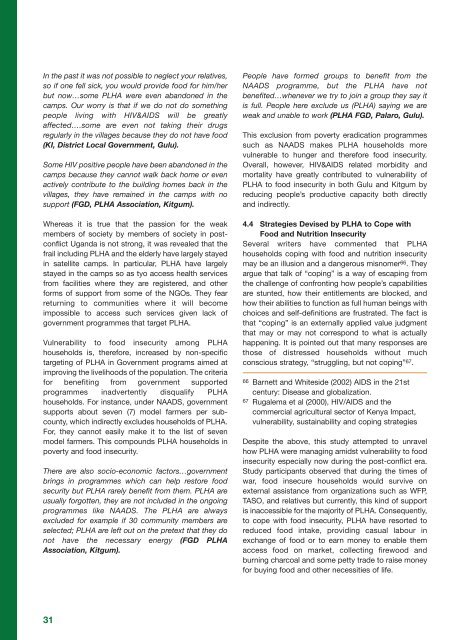Uganda Report 2012 FINAL PO:Layout 1 - ACORD
Uganda Report 2012 FINAL PO:Layout 1 - ACORD
Uganda Report 2012 FINAL PO:Layout 1 - ACORD
You also want an ePaper? Increase the reach of your titles
YUMPU automatically turns print PDFs into web optimized ePapers that Google loves.
In the past it was not possible to neglect your relatives,<br />
so if one fell sick, you would provide food for him/her<br />
but now…some PLHA were even abandoned in the<br />
camps. Our worry is that if we do not do something<br />
people living with HIV&AIDS will be greatly<br />
affected….some are even not taking their drugs<br />
regularly in the villages because they do not have food<br />
(KI, District Local Government, Gulu).<br />
Some HIV positive people have been abandoned in the<br />
camps because they cannot walk back home or even<br />
actively contribute to the building homes back in the<br />
villages, they have remained in the camps with no<br />
support (FGD, PLHA Association, Kitgum).<br />
Whereas it is true that the passion for the weak<br />
members of society by members of society in postconflict<br />
<strong>Uganda</strong> is not strong, it was revealed that the<br />
frail including PLHA and the elderly have largely stayed<br />
in satellite camps. In particular, PLHA have largely<br />
stayed in the camps so as tyo access health services<br />
from facilities where they are registered, and other<br />
forms of support from some of the NGOs. They fear<br />
returning to communities where it will become<br />
impossible to access such services given lack of<br />
government programmes that target PLHA.<br />
Vulnerability to food insecurity among PLHA<br />
households is, therefore, increased by non-specific<br />
targeting of PLHA in Government programs aimed at<br />
improving the livelihoods of the population. The criteria<br />
for benefiting from government supported<br />
programmes inadvertently disqualify PLHA<br />
households. For instance, under NAADS, government<br />
supports about seven (7) model farmers per subcounty,<br />
which indirectly excludes households of PLHA.<br />
For, they cannot easily make it to the list of seven<br />
model farmers. This compounds PLHA households in<br />
poverty and food insecurity.<br />
There are also socio-economic factors…government<br />
brings in programmes which can help restore food<br />
security but PLHA rarely benefit from them. PLHA are<br />
usually forgotten, they are not included in the ongoing<br />
programmes like NAADS. The PLHA are always<br />
excluded for example if 30 community members are<br />
selected; PLHA are left out on the pretext that they do<br />
not have the necessary energy (FGD PLHA<br />
Association, Kitgum).<br />
People have formed groups to benefit from the<br />
NAADS programme, but the PLHA have not<br />
benefited…whenever we try to join a group they say it<br />
is full. People here exclude us (PLHA) saying we are<br />
weak and unable to work (PLHA FGD, Palaro, Gulu).<br />
This exclusion from poverty eradication programmes<br />
such as NAADS makes PLHA households more<br />
vulnerable to hunger and therefore food insecurity.<br />
Overall, however, HIV&AIDS related morbidity and<br />
mortality have greatly contributed to vulnerability of<br />
PLHA to food insecurity in both Gulu and Kitgum by<br />
reducing people’s productive capacity both directly<br />
and indirectly.<br />
4.4 Strategies Devised by PLHA to Cope with<br />
Food and Nutrition Insecurity<br />
Several writers have commented that PLHA<br />
households coping with food and nutrition insecurity<br />
may be an illusion and a dangerous misnomer 66 . They<br />
argue that talk of “coping” is a way of escaping from<br />
the challenge of confronting how people’s capabilities<br />
are stunted, how their entitlements are blocked, and<br />
how their abilities to function as full human beings with<br />
choices and self-definitions are frustrated. The fact is<br />
that “coping” is an externally applied value judgment<br />
that may or may not correspond to what is actually<br />
happening. It is pointed out that many responses are<br />
those of distressed households without much<br />
conscious strategy, “struggling, but not coping” 67 .<br />
66 Barnett and Whiteside (2002) AIDS in the 21st<br />
century: Disease and globalization.<br />
67 Rugalema et al (2000), HIV/AIDS and the<br />
commercial agricultural sector of Kenya Impact,<br />
vulnerability, sustainability and coping strategies<br />
Despite the above, this study attempted to unravel<br />
how PLHA were managing amidst vulnerability to food<br />
insecurity especially now during the post-conflict era.<br />
Study participants observed that during the times of<br />
war, food insecure households would survive on<br />
external assistance from organizations such as WFP,<br />
TASO, and relatives but currently, this kind of support<br />
is inaccessible for the majority of PLHA. Consequently,<br />
to cope with food insecurity, PLHA have resorted to<br />
reduced food intake, providing casual labour in<br />
exchange of food or to earn money to enable them<br />
access food on market, collecting firewood and<br />
burning charcoal and some petty trade to raise money<br />
for buying food and other necessities of life.<br />
31





